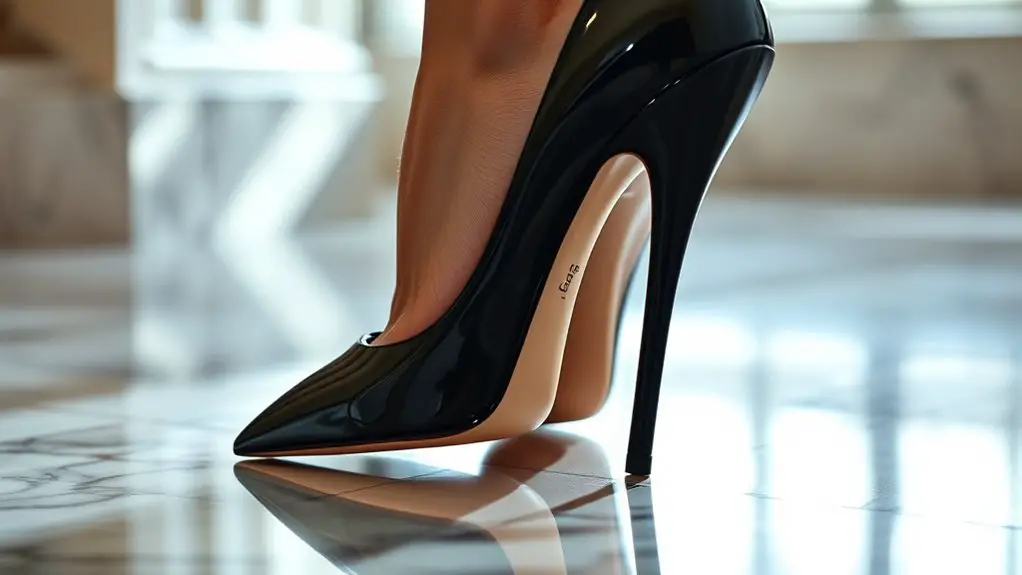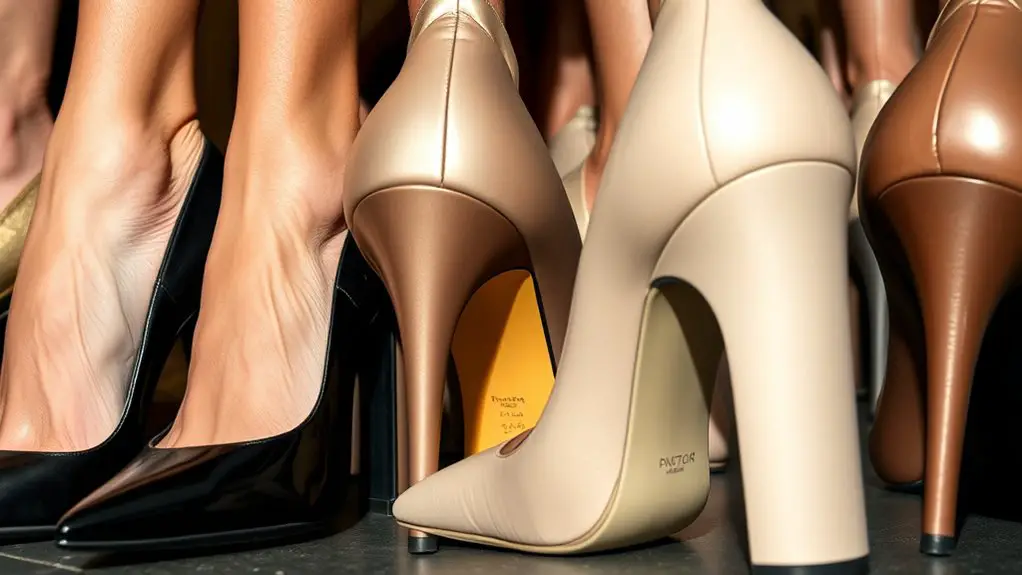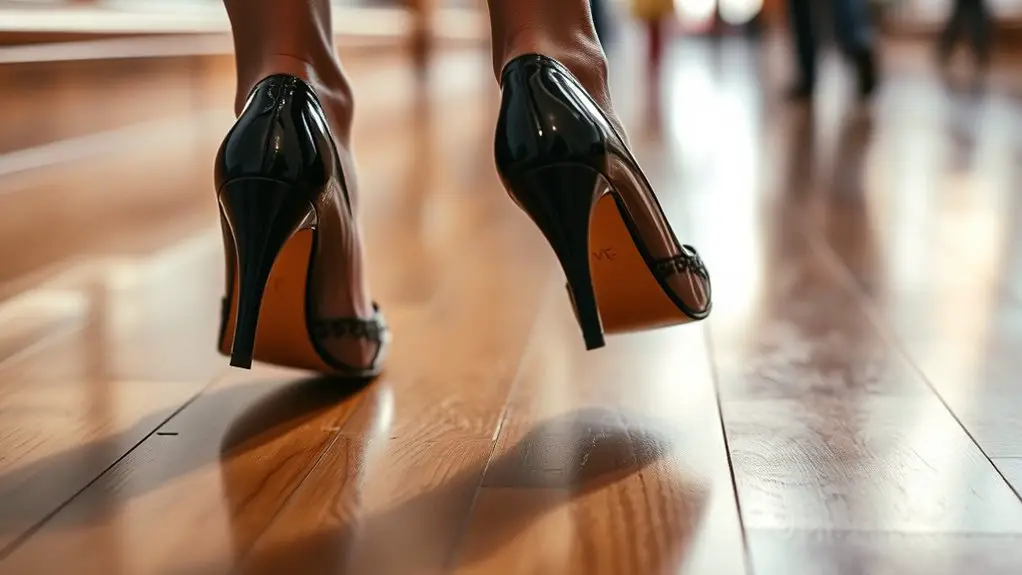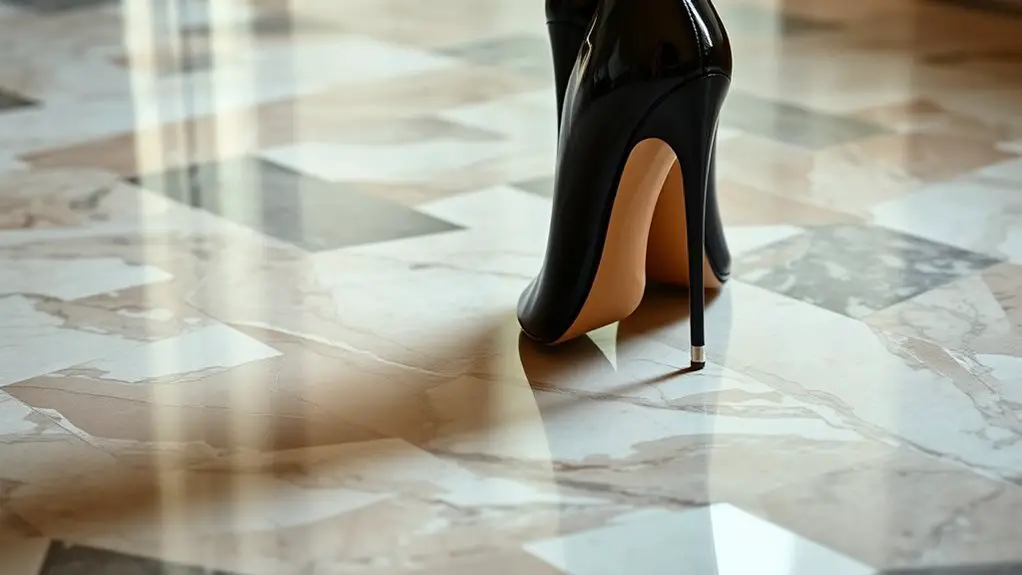High heels can make loud clicking sounds when you walk due to factors like their anatomy, materials, and your walking style. Heels with thinner soles or higher heights amplify sound, while materials like hard plastic create sharper clicks. How you walk also matters; confident strides enhance those striking noises. The flooring underfoot plays a role too, with hardwood amplifying sounds while carpet muffles them. Want to discover more nuances behind that attention-grabbing sound?
The Anatomy of High Heels

High heels, those iconic symbols of fashion and empowerment, boast a complex anatomy that goes beyond mere aesthetics. When you slip into a pair, you’re not just enhancing your height; you’re engaging with a carefully engineered structure. The heel height plays a vital role in your overall posture and balance. A higher heel can create an elegant silhouette but may also challenge your stability.
Sole thickness is another key component. Thicker soles often provide better cushioning, allowing for a comfortable stride, while thinner soles might amplify that chic, sophisticated look but can lead to discomfort over time. The interplay between heel height and sole thickness not only affects your comfort but also influences the sound your heels make as you walk. Understanding this anatomy helps you choose the perfect pair that marries style with functionality, making each step a confident statement.
Materials Matter: How They Affect Sound
The materials used in high heels greatly influence not just comfort and durability, but also the sounds they produce as you walk. When you think of heel materials, consider how hard plastics or sleek leather can create a sharper, more pronounced clicking sound, while softer materials like suede or rubber tend to muffle it. This distinction is essential if you’re aiming to make a statement with your footwear.
The sound frequency generated by your heels can also be affected by the weight and density of the materials. A heavier heel might produce a deeper thud, whereas lighter materials will resonate at higher frequencies, creating that iconic click. If you’re looking to stand out, opt for heels crafted from polished wood or metallic accents—they’re not only trendy but also amplify sound, ensuring you make your entrance memorable. Choose wisely, as the materials can elevate your style and sound game!
Heel Shape and Design Influences

While you might not immediately consider it, the shape and design of your heels play an essential role in the sounds they create as you strut your stuff. Different heel types—like stilettos, block heels, or kitten heels—affect the sound frequency produced with each step. Stilettos, with their slender, pointed design, tend to produce a sharper, higher-pitched click, while block heels offer a deeper thud due to their broader base.
The materials used in the heel’s construction also come into play; a wooden heel may create a different resonance compared to a plastic one. Additionally, the angle of the heel contributes to how sound travels and echoes off surfaces. So, next time you slip on a pair of heels, think about their shape and design—it’s not just about style; it’s about the statement you make with every confident step you take.
Walking Style: The Role of Technique
Heel shape and design certainly set the stage for the sounds your shoes make, but it’s your walking style that truly brings those sounds to life. Your walking posture plays a critical role; a confident, upright stance not only enhances your presence but also accentuates the clicking of your heels. When you stride with intention, the sound resonates, creating a striking rhythm that commands attention.
Heel height is another factor; taller heels often amplify sound, making every step more pronounced. If you’ve got a tendency to walk heavily, the clicks become even louder, turning heads as you move.
To master the art of sound, focus on a fluid motion—smooth shifts and gentle foot placement can transform a clunky walk into a melodic stride. With the right technique, you can make your heels not just a fashion statement, but a mesmerizing soundtrack to your every step.
Sound Absorption: The Impact of Flooring

When you step onto different types of flooring, the sound your heels make can drastically change, influencing not only how you feel but also how others perceive you. The right floor type can enhance or diminish that signature click, depending on its sound dampening qualities.
Here’s a quick look at how various floorings affect heel sounds:
| Floor Type | Sound Dampening Quality | Effect on Heel Sound |
|---|---|---|
| Hardwood | Low | Loud Click |
| Carpet | High | Soft Thud |
| Tile | Moderate | Clear Click |
Choosing your footwear in relation to the flooring can be a game changer. If you’re walking on hardwood, you might want to embrace that loud click as a confidence booster. On carpet, you’ll enjoy a quieter, more subdued presence. Each floor type creates a unique auditory experience!
Frequently Asked Questions
Do Certain Brands Have Noisier Heels Than Others?
Absolutely, brand comparisons reveal that some brands prioritize style over silence. Material choices greatly impact sound; harder materials often create louder clicks. Opt for brands known for quieter designs if you prefer a more discreet step.
Can Heel Height Influence the Clicking Sound?
Yes, heel height can influence the clicking sound. Higher heels often have less sound absorption due to their design, amplifying noise. Opt for styles that balance height with materials that minimize clacking for a quieter step.
Are There Specific Heel Types That Are Quieter?
Yes, there are quiet heel types, like block heels or wedges. The material impact matters too—rubber soles absorb sound better than hard materials, giving you a chic look without the clack. Choose wisely!
How Can I Reduce Noise From My Heels?
Ever wondered how to walk quietly in heels? Try adding heel padding for comfort and sound dampening. These subtle adjustments not only reduce noise but also elevate your style, keeping you chic and discreet during any occasion.
Do Loud Heels Indicate Poor Quality Construction?
Loud heels don’t always mean poor quality; they often relate to heel materials and noise factors. High-quality heels can still click if designed for style over sound, so it’s essential to choose wisely for your needs.



